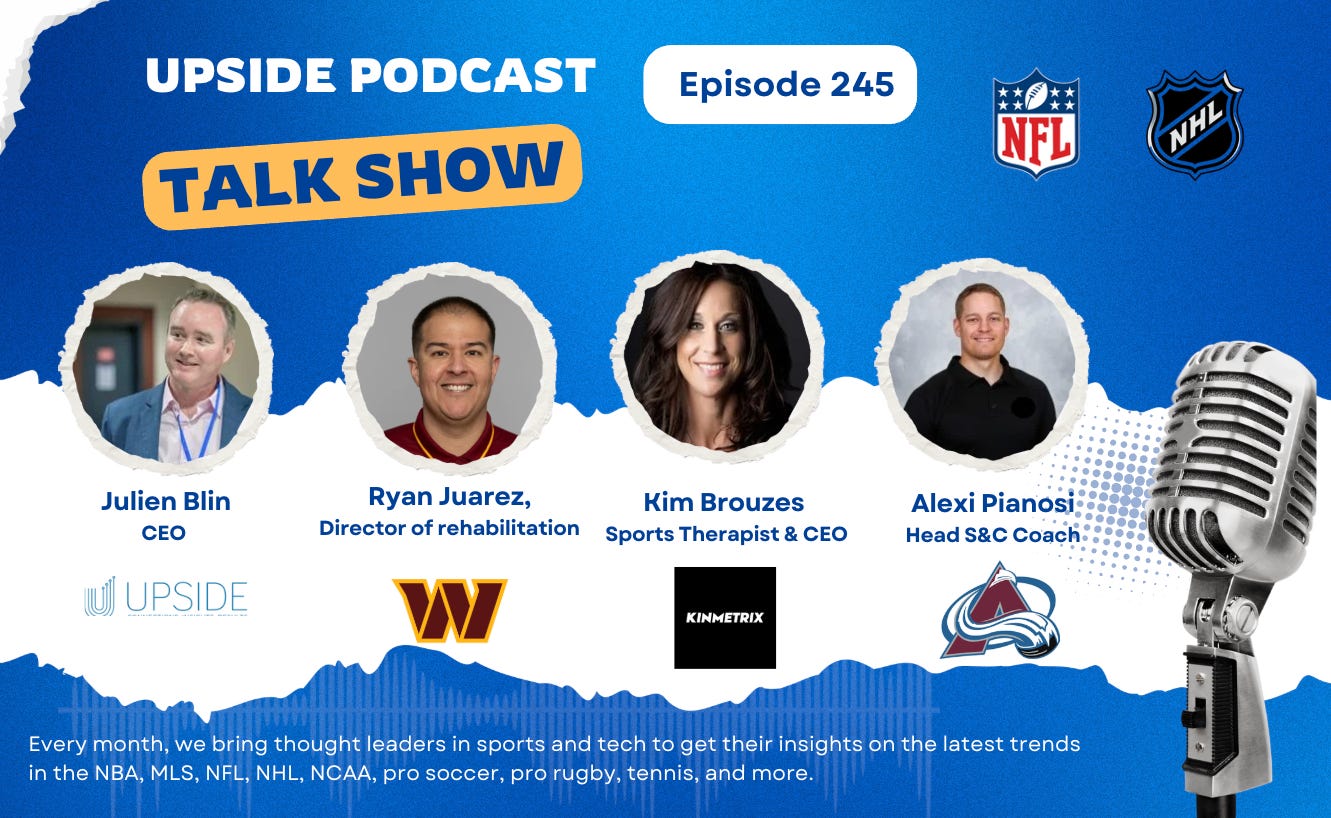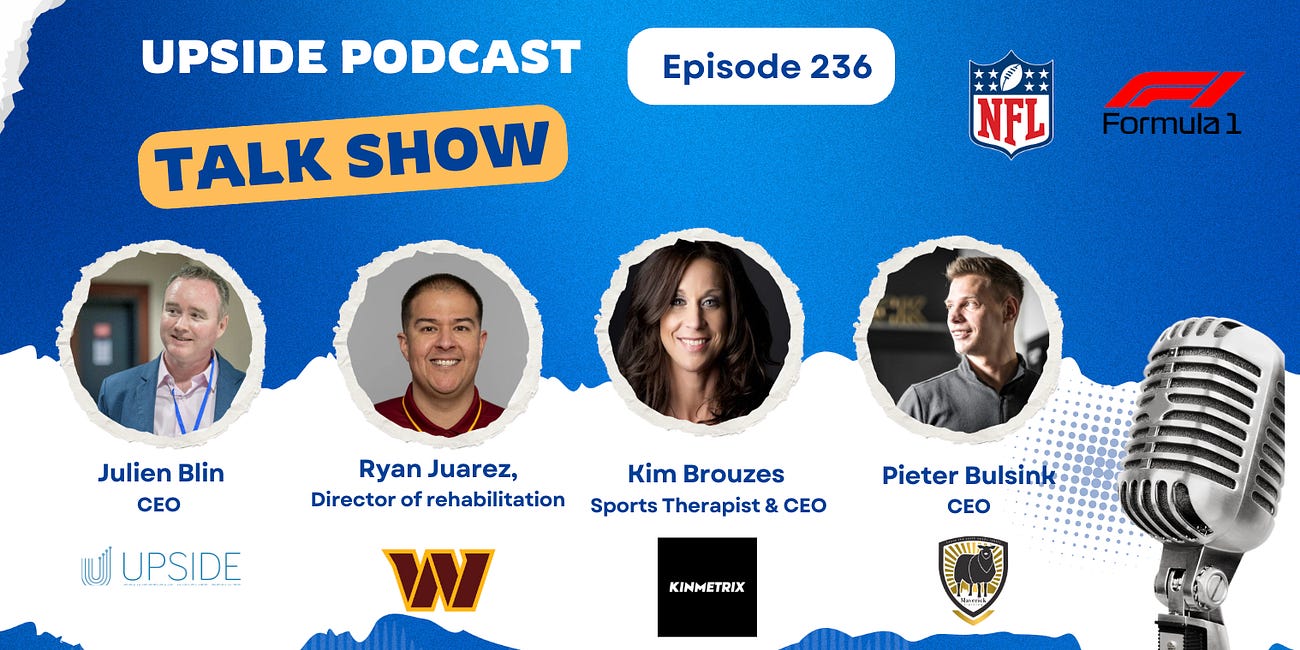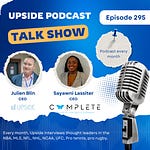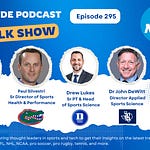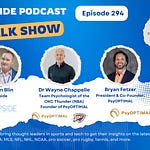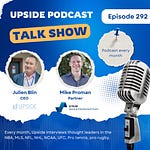This week we have the honor to interview a group of rehab and performance experts across the NFL and NHL. We discussed concussion assessment and management, their approach to this topic, the various modalities, best practices and trends that they are seeing in the market.
Alexi Pianosi, Head S&C coach at the Colorado Avalanche, an NHL team.
Kim Brouzes, an experienced Canadian sports therapist and CEO of Kinmetrix which built an advanced neck strengthening device collecting data.
Ryan Juarez, the director of rehabilitation at the Commanders, an NFL team.
📝Show Notes: Through this interview, we touched on concussion assessment and management related topics especially:
How concussion assessment protocols have evolved in their sports over the past few years, and which new tools or technologies (e.g., SCAT6, eye-tracking, neurocognitive platforms, and in-race or in-game monitoring) are being integrated today.
What roles wearable technologies, video analysis, saliva analysis, connected mouth guards, sensor based helmets, or AI are playing in real-time concussion detection and post-impact evaluation across their sports (NFL, NHL).
How sports organizations handle education and awareness for players, coaches, and staff around concussion risk, symptoms, and reporting culture.
Looking forward, what they see as the next frontier in concussion prevention or management—whether it’s data, equipment, policy, and so on.
You can read the full transcript of the podcast interview located at the top of this blog post.
Here are some of the best quotes of our conversation with Alexi, Kim and Ryan:
1. How have concussion assessment protocols evolved, and what new tools are being integrated?
Kim Brouzes:
“In Ontario, we have something called Rowan’s Law. It came about after Rowan Stringer, a young athlete, tragically passed away from Second Impact Syndrome. This law brought in strict rules for diagnosing and managing concussions. If a concussion is suspected, the athlete must be referred to a doctor or nurse practitioner for diagnosis, and then they're put into what we call a protocol. We mandate 24 hours of brain rest, then begin aerobic activity, neck treatments, and from there we figure out what type of concussion they’re dealing with—whether it's visual, vestibular, cervicogenic, or another type. There are about six different systems we consider. This informs the specific treatment plan and helps us guide them through recovery in a structured, safe manner. It’s a highly legislated and systematic approach designed to prioritize athlete health.”
Ryan Juarez:
“When I started in the NFL as an intern in 2005, concussion protocols were pretty limited. By 2012, when I came back full time, awareness had improved, but we were still figuring a lot out. Now, things have evolved tremendously in a positive way. In the NFL, we use tools like C3 Logic as part of baseline and return-to-play screening, and we still use Impact testing. At the college level, I’ve also worked with Sway, which assesses balance. There are now spotters in the booth looking for visible signs during games, and we’ve got league- and conference-driven assessment protocols we have to follow. All of this is a far cry from when I started. We’re more structured, more evidence-driven, and far better equipped to identify and manage concussions.”
Alexi Pianosi:
“Over the last 10 years, concussion management has improved significantly, especially in pro sports. But what's also become clear is how little we still know. We’ve moved away from a one-size-fits-all approach, and now recognize that different teams, organizations, and even individual practitioners can approach concussion management differently. Some are more risk-averse, some are quicker to return players based on symptoms and initial tests. That variability isn’t necessarily bad—it allows for creativity and innovation—but it also means there’s no standardized protocol across the board. Laws like Rowan’s Law are a step toward consistency, but we’re still in the early stages of understanding how to best manage and treat concussions comprehensively.”
2. What role are wearable technologies, video analysis, saliva analysis, connected mouthguards, or AI playing? Differences across sports?
Ryan Juarez:
“I’ve had experience using sensor-based helmets and connected mouthguards, particularly at the college level. We used them to identify the type and location of impacts, which helped inform practice planning—like what drills might be causing more head contact. We also had a donor-funded saliva biomarker study with our women’s lacrosse team, which was fascinating. I’m still learning about a lot of this newer tech—AI, surface EMG, etc.—but I’m excited by it. One example Kim told me about was a Canadian researcher using EMG sensors on the knees to track the delay in brain-to-muscle signal transmission post-concussion. That’s pretty wild and really promising. But even with all the tech, I keep reminding myself and others: sometimes, good clinical judgment and knowing your athlete can be the most valuable tools.”
Kim Brouzes:
“There’s a ton of innovation right now—saliva testing for biomarkers post-concussion, surface EMG sensors showing delayed muscle responses linked to the autonomic nervous system, eye tracking, AI... But no matter how many tools you have, we can’t overlook the importance of the human element. When you know your athlete, you see mood changes, eye movement differences, or how they carry themselves. That’s something tech can’t fully replicate. It’s exciting to have all these new ways to gather data, but you’ve got to use your instincts and experience too. Impact and symptom should still equal removal from play, full stop.”
Alexi Pianosi:
“There’s a ton of promise in wearable devices, saliva testing, and other tech, but we’re not at the point where we can definitively say, ‘This metric means a concussion.’ It’s not like speeding on a highway where 65 mph is a clear threshold. You might see one guy take a massive hit and bounce back totally fine, while another barely gets touched and can’t remember who you are. The variability is massive. So we need to gather data on mouthguards, biomarkers, reaction time—all of it—but we also need to understand what those measurements mean in context. Eventually, I hope we’ll get to a point where we can say, ‘This sensor measures the vestibular response really well, this one the visual system,’ and build an integrated view of what a concussion really looks like on multiple levels.”
3. How does your organization handle education and awareness around concussions?
Alexi Pianosi:
“In the NHL, every training camp starts with a mandatory concussion education video. It features former players sharing their stories and symptoms. It’s definitely valuable, though for veterans it can get repetitive over time. That said, the cultural shift is the most important part. The old ‘play through it’ mentality is mostly gone now. Players take it seriously. If they’ve got symptoms, they speak up. And that’s a huge step forward for long-term brain health and player safety.”
Ryan Juarez:
“In both the NFL and at the college level, there’s required education at the start of every season. The biggest change I’ve seen, though, is how players look out for each other. Ten years ago, guys would hide symptoms to stay on the field. Now, you’ll hear teammates saying, ‘Go get checked out.’ That shift in peer culture is powerful. The more that happens, the more likely we are to catch injuries early and keep guys safe.”
Kim Brouzes:
“Here in Ontario, the education component is taken seriously. Athletes and coaches must complete online training at the start of the season. Anyone—coaches, trainers, even media—can pull a player out if a concussion is suspected. The messaging is improving, too. It’s less fear-based now and more about empowerment and awareness. When you tell athletes they may not feel like themselves for a while, and that’s normal, it helps. We educate all the way from preseason to post-return to play.”
4. What is the next frontier in concussion prevention or management?
Alexi Pianosi:
“Total prevention seems unlikely in collision sports like football or hockey. You’ve got big athletes moving fast—it’s part of the game. But the next big steps are better detection and better rehab. On the sideline, real-time diagnostics like mouthguards or saliva testing will be game-changers once the science catches up. And for the tougher cases—those 5 to 10% that don’t follow the normal recovery path—we’ll need better ways to address specific systems, like vestibular or visual issues. It’s going to take both technological innovation and clinical expertise.”
Ryan Juarez:
“If I could dream big, I’d love to see sideline tech that gives you an accurate, immediate read on whether a player has a concussion. That would be huge. I also believe in equipment upgrades—we’ve used Guardian Caps and saw our concussion numbers drop by half. That’s a real impact. And the more data we have—whether it’s load tracking, EMG, or reaction metrics—the more confident we can be about when a player is really ready to come back.”
Kim Brouzes:
“We might not be able to fully prevent concussions, but we can reduce their severity and improve how we manage them. That means fewer hits in practice, strengthening the neck, delaying contact sports until kids are older, and understanding things like sleep and nervous system balance. If we can build a profile on each athlete—their physiology, their normal responses—we can be more precise when something’s off. But I agree, knowing exactly when a concussion happens and acting quickly is the biggest leap we can make.”
You may also like:
🔥Upside NFL/F1 Group Chat with Pieter Bulsink (Maverick Training/F1), Kim Brouzes (Kinmetrix), Ryan Juarez (Commanders/NFL) On Neck Training
This week we have the honor to interview a group of rehab and performance experts across the NFL and F1. We discussed neck training, their approach to neck training, the various modalities, best practices and trends that they are seeing in the market.


